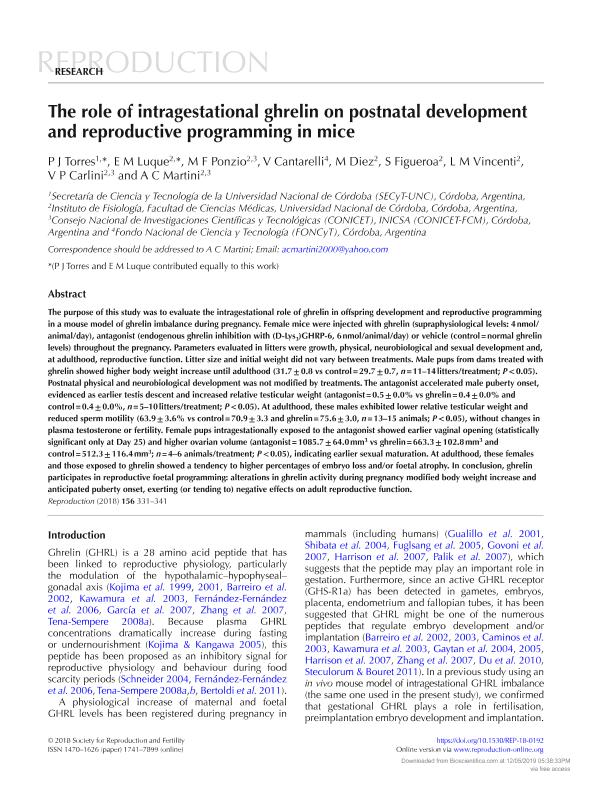Mostrar el registro sencillo del ítem
dc.contributor.author
Torres, Pedro Javier

dc.contributor.author
Luque, Eugenia Mercedes

dc.contributor.author
Ponzio, Marina Flavia

dc.contributor.author
Cantarelli, Verónica Inés

dc.contributor.author
Diez, Marcela

dc.contributor.author
Figueroa, S.
dc.contributor.author
Vincenti, Laura María

dc.contributor.author
Carlini, Valeria Paola

dc.contributor.author
Martini, Ana Carolina

dc.date.available
2019-12-05T17:57:02Z
dc.date.issued
2018-05
dc.identifier.citation
Torres, Pedro Javier; Luque, Eugenia Mercedes; Ponzio, Marina Flavia; Cantarelli, Verónica Inés; Diez, Marcela; et al.; The role of intragestational ghrelin on postnatal development and reproductive programming in mice; BioScientifica; Reproduction; 156; 4; 5-2018; 331-351
dc.identifier.issn
1470-1626
dc.identifier.uri
http://hdl.handle.net/11336/91504
dc.description.abstract
The purpose of this study was to evaluate the intragestational role of ghrelin in offspring development and reproductive programming in a mouse model of ghrelin imbalance during pregnancy. Female mice were injected with ghrelin (supraphysiological levels: 4 nmol/animal/day), antagonist (endogenous ghrelin inhibition with (D-Lys3)GHRP-6, 6 nmol/animal/day) or vehicle (control = normal ghrelin levels) throughout the pregnancy. Parameters evaluated in litters were growth, physical, neurobiological and sexual development and, at adulthood, reproductive function. Litter size and initial weight did not vary between treatments. Male pups from dams treated with ghrelin showed higher body weight increase until adulthood (31.7 ± 0.8 vs control = 29.7 ± 0.7, n = 11-14 litters/treatment; P < 0.05). Postnatal physical and neurobiological development was not modified by treatments. The antagonist accelerated male puberty onset, evidenced as earlier testis descent and increased relative testicular weight (antagonist = 0.5 ± 0.0% vs ghrelin = 0.4 ± 0.0% and control = 0.4 ± 0.0%, n = 5-10 litters/treatment; P < 0.05). At adulthood, these males exhibited lower relative testicular weight and reduced sperm motility (63.9 ± 3.6% vs control = 70.9 ± 3.3 and ghrelin = 75.6 ± 3.0, n = 13-15 animals; P < 0.05), without changes in plasma testosterone or fertility. Female pups intragestationally exposed to the antagonist showed earlier vaginal opening (statistically significant only at Day 25) and higher ovarian volume (antagonist = 1085.7 ± 64.0 mm3 vs ghrelin = 663.3 ± 102.8 mm3 and control = 512.3 ± 116.4 mm3; n = 4-6 animals/treatment; P < 0.05), indicating earlier sexual maturation. At adulthood, these females and those exposed to ghrelin showed a tendency to higher percentages of embryo loss and/or foetal atrophy. In conclusion, ghrelin participates in reproductive foetal programming: Alterations in ghrelin activity during pregnancy modified body weight increase and anticipated puberty onset, exerting (or tending to) negative effects on adult reproductive function.
dc.format
application/pdf
dc.language.iso
eng
dc.publisher
BioScientifica

dc.rights
info:eu-repo/semantics/openAccess
dc.rights.uri
https://creativecommons.org/licenses/by-nc-nd/2.5/ar/
dc.subject
GHRELIN
dc.subject
(D-Lys 3)GHRP-6
dc.subject
FETAL PROGRAMMING
dc.subject
REPRODUCTIVE PROGRAMMING
dc.subject.classification
Biología Reproductiva

dc.subject.classification
Ciencias Biológicas

dc.subject.classification
CIENCIAS NATURALES Y EXACTAS

dc.title
The role of intragestational ghrelin on postnatal development and reproductive programming in mice
dc.type
info:eu-repo/semantics/article
dc.type
info:ar-repo/semantics/artículo
dc.type
info:eu-repo/semantics/publishedVersion
dc.date.updated
2019-10-22T16:44:09Z
dc.journal.volume
156
dc.journal.number
4
dc.journal.pagination
331-351
dc.journal.pais
Reino Unido

dc.journal.ciudad
Bristol
dc.description.fil
Fil: Torres, Pedro Javier. Universidad Nacional de Córdoba. Secretaria de Ciencia y Tecnología; Argentina
dc.description.fil
Fil: Luque, Eugenia Mercedes. Consejo Nacional de Investigaciones Científicas y Técnicas. Centro Científico Tecnológico Conicet - Córdoba. Instituto de Investigaciones en Ciencias de la Salud. Universidad Nacional de Córdoba. Instituto de Investigaciones en Ciencias de la Salud; Argentina
dc.description.fil
Fil: Ponzio, Marina Flavia. Consejo Nacional de Investigaciones Científicas y Técnicas. Centro Científico Tecnológico Conicet - Córdoba. Instituto de Investigaciones en Ciencias de la Salud. Universidad Nacional de Córdoba. Instituto de Investigaciones en Ciencias de la Salud; Argentina
dc.description.fil
Fil: Cantarelli, Verónica Inés. Ministerio de Ciencia, Tecnología e Innovación Productiva. Agencia Nacional de Promoción Científica y Tecnológica. Fondo para la Investigación Científica y Tecnológica; Argentina
dc.description.fil
Fil: Diez, Marcela. Universidad Nacional de Córdoba. Facultad de Medicina; Argentina. Consejo Nacional de Investigaciones Científicas y Técnicas; Argentina
dc.description.fil
Fil: Figueroa, S.. Universidad Nacional de Córdoba. Facultad de Medicina; Argentina
dc.description.fil
Fil: Vincenti, Laura María. Universidad Nacional de Córdoba. Facultad de Medicina; Argentina
dc.description.fil
Fil: Carlini, Valeria Paola. Consejo Nacional de Investigaciones Científicas y Técnicas. Centro Científico Tecnológico Conicet - Córdoba. Instituto de Investigaciones en Ciencias de la Salud. Universidad Nacional de Córdoba. Instituto de Investigaciones en Ciencias de la Salud; Argentina
dc.description.fil
Fil: Martini, Ana Carolina. Consejo Nacional de Investigaciones Científicas y Técnicas. Centro Científico Tecnológico Conicet - Córdoba. Instituto de Investigaciones en Ciencias de la Salud. Universidad Nacional de Córdoba. Instituto de Investigaciones en Ciencias de la Salud; Argentina
dc.journal.title
Reproduction

dc.relation.alternativeid
info:eu-repo/semantics/altIdentifier/doi/https://doi.org/10.1530/REP-18-0192
dc.relation.alternativeid
info:eu-repo/semantics/altIdentifier/url/rep.bioscientifica.com/view/journals/rep/156/4/REP-18-0192.xml
Archivos asociados
